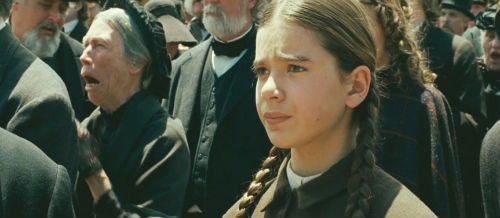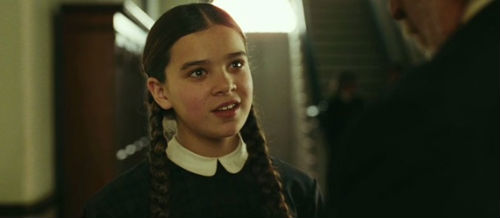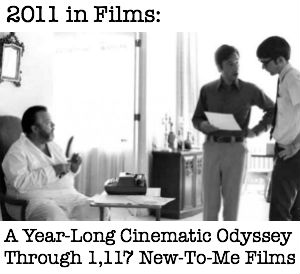Hailee Steinfeld and the Best Supporting Actress Race
There’s been a lot of chatter as of late on Twitter about 14 year-old Hailee Steinfeld’s chances at an Oscar nomination and whether her performance should be considered for Best Actress or Best Supporting Actress. The debate seems to be whether the role is a lead role or a supporting role. While I think it is a lead role, what is really in question is where she has the best chance of getting a nomination – and even perhaps winning. That’s how studios decide how to campaign a role. Though Steinfeld is the heart of True Grit, she has the best chance in the Best Supporting Actress category.
This year’s Best Supporting Actress race seems to be one of the more interesting races. We’ve got at least four great contenders: Hailee Steinfeld in True Grit, Jacki Weaver in Animal Kingdom and Melissa Leo & Amy Adams in The Fighter. This, of course, is assuming The Academy puts Steinfeld in the supporting category. I thought this would be a good time to talk about a few trends I’ve noticed in the category over the years.
No Small Parts
I remember in 2005 reading a lot of bloggers discussing whether Rachel Weisz would win the Oscar for her role in The Constant Gardener even though her character is only in the film for about 30 minutes and she disappears early on in the film. The Academy, however, I believe is a firm believer in “There are no small parts, only small actors.” In 1959 Hermione Baddeley was nominated for Best Supporting Actress in A Room At The Top with only 2 minutes and 20 seconds of screen time. Sylvia Miles was nominated for the award in 1969 for her role in Midnight Cowboy with only 5 minutes and 46 seconds of screen time. Beatrice Straight WON the award for her role in 1976’s Network with only 5 minutes and 40 seconds of screen time. Most recently, Dame Judi Dench WON the award in 1998 for her role as Queen Elizabeth I in Shakespeare In Love, with just under 6 minutes of screen time.
Splitting the Vote
In the last twenty years we’ve had several films come up with two Best Supporting Actress nominations. In 1994 Woody Allen’s Bullet’s Over Broadway, both Dianne Wiest and Jennifer Tilly were nominated in the category. Wiest wound up winning the award, her second in the Best Supporting Actress category. Incidentally, both her wins were in Woody Allen films. In 2008 both Amy Adams and Viola Davis were nominated for their roles in Doubt. Neither walked away with a win; Penelope Cruz won for her role in Woody Allen’s Vicky Cristina Barcelona. Other recent split nominations: Vera Farmiga and Anna Kendrick in 2009’s Up In The Air, Adriana Barraza and Rinko Kikuchi in 2006’s Babel, Catherine Zeta-Jones and Queen Latifah in 2002’s Chicago, Helen Mirren and Maggie Smith in 2001’s Gosford Park and Kate Hudson and Frances McDormand in 2000’s Almost Famous.
The Youth Vote
Every ten to fifteen years we wind up with a child performance that makes such an impact it gets nominated, or even wins, in the Best Supporting Actress category. In 1962 Patty Duke won for her role as Helen Keller in The Miracle Worker. In 1973 Tatum O’Neal won at the age of ten for her role in Paper Moon. 1972 was also a split year; O’Neal’s co-star Madeline Kahn was also nominated in the Best Supporting Actress category. Anna Paquin was eleven years old when she won for her role in 1992’s The Piano. I thought Dakota Fanning would get a nomination for her role in 2001’s I Am Sam. At seven years old she would have been the youngest nominee ever for any competitive Academy Award. Recently, Abigail Breslin was ten years old when she was nominated for 2006’s Little Miss Sunshine.
Lead or Supporting?
Like I said earlier, sometimes a studio will push a role as supporting because they think it will have a better chance in that category despite the role being what many would consider a lead. In the last ten years, this strategy has worked well twice, but also led to much confusion. In 2001 Jennifer Connelly won several precursors, including a Golden Globe, in the supporting category for her role in A Beautiful Mind, when was nominated in the lead category by the Screen Actors Guild. Regardless of the SAG category confusion, Connelly got nominated and won at the Academy Awards as Best Supporting Actress. The next year Catherine Zeta-Jones got a lead nomination at the Golden Globes for her role in Chicago, where she lost to Renee Zellweger. She went on the win the SAG and the Oscar as Best Supporting Actress. In 2003, 13 year-old Keisha Castle-Hughes was campaigned as either supporting or youth for her role in Whale Rider, nabbing a handful of precursor nominations and a SAG nomination for Best Supporting Actress. Then came the Academy Award nominations, where Hughes was nominated as Best Actress – the youngest nominee in that category ever. The most recent example of category confusion happened in 2008, where Kate Winslet was aggressively campaigned as in the supporting category for her role in The Reader, winning the Critics Choice, Golden Globe and SAG in that category. The Academy, however nominated her as Best Actress. This was Winslet’s sixth acting nomination, and her first win.
So what does this all mean for Steinfeld? She’s definitely on screen long enough to warrant a nomination. She commands every scene she’s in and goes head-to-head with Oscar winners Jeff Bridges and Matt Damon, and as far as I’m concerned comes out ahead. She’s not so young as to set a precedent, so although her age is a bit of an issue, it’s not as big an obstacle as it could be. Although she wasn’t nominated for a Golden Globe, she has several critic wins, as well as a nominations from the Screen Actors Guild and the Broadcast Film Critics Association (in the supporting category). If she does get nominated for Best Actress, she will have a hell of a time beating frontrunners and previous Oscar nominees Natalie Portman and Annette Bening. If she gets nominated in the Best Supporting Actress category, history is more on her side. Plus, if both Amy Adams and Melissa Leo get nominated for their roles in The Fighter, they could split the vote in favor of Steinfeld. Pundits are pleading to True Grit supporters in the Academy to write her name at the top of their ballots in BOTH categories, just in case. I definitely think this is a good idea because nominations are tabulated preferentially (though voting on the eventual nominees are not, except for Best Picture). I do hope she manages to get a nominations one way or another. I guess in just under three weeks we shall see.
Posted on January 9, 2011, in the Academy Awards and tagged Abigail Breslin, Amy Adams, Beatrice Straight, Catherine Zeta-Jones, Dakota Fanning, Dame Judi Dench, Dianne Wiest, Hailee Steinfeld, Hermione Baddeley, Jacki Weaver, Jennifer Connelly, Jennifer Tilly, Melissa Leo, Patty Duke, Rachel Weisz, Sylvia Miles, Tatum O'Neal, Viola Davis. Bookmark the permalink. 4 Comments.























This is definitely going to be one of the more interesting events as AMPAS unveils its nominations. Steinfeld without question is a lead, as she is in nearly every single scene in the film. Category fraud is an unfortunate reality though, so I expect we will see her in the Supporting field. Either way, I will be happy as long as she is recognized somewhere. She was absolutely incredible, and is the best part of one of the best films of the year.
Here’s hoping!
Pingback: 15 Breakthrough Performers of 2010 « the diary of a film awards fanatic
Pingback: PDX RETRO
Pingback: Female Filmmaker Friday: The Edge of Seventeen, 2016 (dir. Kelly Fremon Craig) | the diary of a film history fanatic